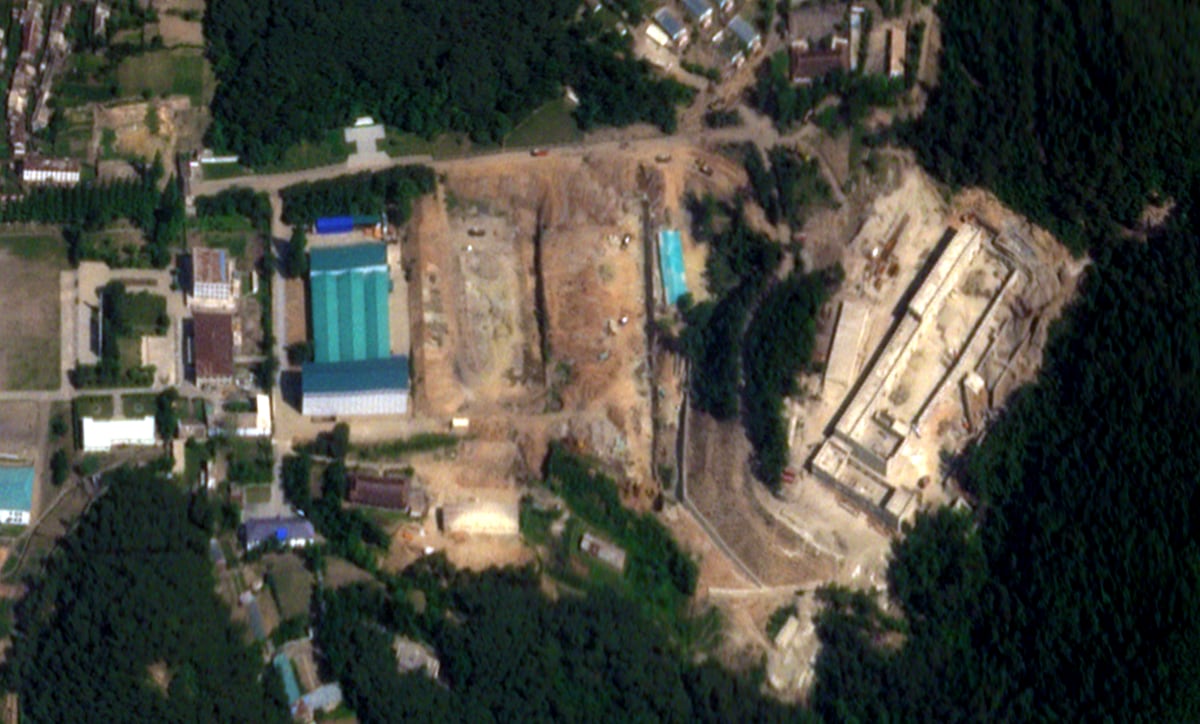



THE HAGUE, Netherlands — Construction at a North Korean missile factory could portend an upgrade to the country’s rocketry capabilities, according to satellite imagery and expert analysis.
The building activities, which began last year at the Chamjin missile factory, 20 driving minutes southwest of Pyongyang, involve a mysterious annex to a factory building that has left outside observers puzzled.
Named the Thaesong machine plant by North Korean state media, the Chamjin missile factory dates back to at least the 1960s, declassified U.S. Keyhole satellite imagery shows. The complex is nestled in a hard-to-access valley between three mountain peaks, secured by checkpoints on the entry roads, and defended by anti-aircraft nests. Wedged in the valley are two factory sites, some residential areas, a rocket engine test stand, and countless tunnel entrances into the sides of the abutting mountains.
At least two generations of the ruling Kim dynasty have visited the missile factory, images released by North Korean state media and independently geolocated reveal, which underscores its importance to the leadership.
Satellite images show that the western industrial area where the construction is currently underway has remained largely untouched for decades. Some of the factory halls were clearly dilapidated, with gaping holes in their roofs. In November 2023, the largest factory hall – the one now hosting the mysterious annex – received a makeover, including a new roof.
Then, in July 2024, large-scale construction began across the facility. Three industrial halls and a series of smaller buildings closer to the tunnel entrances were razed to the ground, foundations were laid for new, larger factory halls, and significant earth-moving work got underway. Simultaneously, the previously reroofed factory hall received its annex.
A separate area of the same complex down the road to the east is known to be involved in the production of liquid-fueled missiles, with state media publishing images of leader Kim Jong-Un inspecting rockets and key components for the engines that appear to have been manufactured there.
A Burmese delegation visited the Chamjin complex in 2008 and reported that it was producing SCUD ground-to-ground missiles. A photo of such a missile that the delegation took appears to have been taken in the eastern section of the facility. Memoirs of an Iranian missile commander similarly include reference to a missile factory “on the road to Nampo,” the port city located to the southwest of Pyongyang.

Less is known about the western area, where the new construction is taking place. In declassified CIA documents from the 1970s, the facility is described as being involved in the production of liquid-fueled anti-aircraft missiles. Parts of the factory are built into the side of a mountain, with several tunnel entrances visible.
Photos released by state media and located by analysts show Kim Jong-Il, the previous leader and Kim Jong-Un’s father, walking through tunnels at the facility. Thanks to these photos – some of which were seen hanging on the wall in a factory museum at the newer, eastern facility – we know that the two areas are organizationally connected.
Between the two halves, this western area is the only that has access to underground facilities, which are usually a staple of North Korean military sites for the relative safety they provide from air strikes. North Korea was all but flattened during the Korean War, when U.S.-led forces dropped 635,000 tons of bombs on the country.
Colin Zwirko, a correspondent for NK News, was the first analyst to publicly confirm the connection between the eastern and western complexes.
After the initial spurt in activity at the western site in 2024, a lull in construction followed. In North Korea, where labor laws are practically nonexistent and the army is commonly marshalled for building, some projects can be completed at breathtaking speed – but the country also faces severe resource constraints and quickly changing leadership priorities, so a halt to construction isn’t uncommon either, said Zwirko.
“That’s something Kim Jong-Un does all the time, where suddenly it will change and they build something new, you know, halfway through the project,” he said. Indeed, some time after the work on the large factory hall near the tunnel entrances stalled, the three large buildings down the road were demolished, and earth-moving work began there.
Observers said it’s too early to say for sure what role the new plant will play in the ecosystem of North Korea’s weapons technology. Confirmation may come only once Kim Jong-Un visits the completed facility and North Korean state media releases images of it. But based on the factory’s history, coinciding announcements and previous trends, some explanations seem particularly likely.
The known use of the Chamjin complex for missile production, coupled with visible architectural indicators, suggests that the area will continue to be involved in missile-related production. One such sign is the tall, narrow, windowless annex attached to the upgraded factory hall farthest down the street from the underground manufacturing tunnels.
The shape of the building suggests it is designed for testing long, tall objects, said John Ford, research associate at the California-based James Martin Center for Nonproliferation Studies, who has been tracking the North Korean missile program.

Missiles fit this description, and not much else does, he said. Similar architectural features – although none exactly like the one in Chamjin – are visible in satellite imagery of other North Korean factories known to be involved in the production of transport-erector launchers, trucks carrying missiles for mobile launch capabilities.
Ford used satellite imagery and shadows to calculate the dimensions of the annex, which he says is around 65 meters long, 18 meters wide and about 15 meters tall. “That isn’t tall enough for the vertical on their largest missiles,” he said, which leaves “much to ponder.”
One possible explanation is that the rebuilt factory will be involved in the production of North Korean air-defense systems of the Pongae 5 or the newer Pongae 6 variant. The latter was announced by Pyongyang earlier this year but has not yet been publicly shown, Ford said.
The dimensions check out, as does the timing and the facility’s history – after all, the CIA had identified it as making anti-aircraft missiles of the SA-2 variety half a century ago. The factory hall with the annex may be involved in the assembly of trucks carrying the anti-aircraft missiles. The tall annex could be used to test the extension of the launcher tubes into their vertical position. The chassis would likely be produced elsewhere, said Ford.
“I speculate it’s likely, but it’s too early to know for sure,” he said.
An alternative explanation might be that the tall portion of the building is used for testing of another sort related to missiles.
“The reason why you would build it tall like this is you want to test the whole missile at once,” said Ford. It would be assembled inside the hall, then hoisted into place by a crane. “Then you would do whatever testing it is to the entire body of the missile.”
Zwirko, the NK News correspondent, pointed out that the construction also coincided with North Korea’s announcement of a new engine for its satellite launch rocket. Last year, Kim Jong-Un announced an ambitious goal of launching three reconnaissance satellites, which the country failed to achieve. Pyongyang has since held radio silence on the topic.
“This could all come together to show us that it’s all stalled because they’re still working on the production of these engines at this factory,” Zwirko said.
But, he cautioned, there was no indication that North Korea was really in need of a mass production facility specifically for space launch engines. And when it comes to missile development, rather than space launch capabilities, North Korea is moving away from liquid fuel, he said, noting that there hadn’t been a liquid-fueled missile test in several years. North Korea has publicly announced its goal of making its entire missile arsenal solid-fuel, which requires no fueling up in the field before launch.
A particular focus of recent military factory upgrades in North Korea has been exports to Russia. For his war against Ukraine, President Vladimir Putin has been importing large numbers of North Korean-made missiles, shells and equipment. Many of the factories producing these items have undergone significant and rapid upgrades since the start of the Moscow-Pyongyang cooperation.
“If the pace is moving along quickly, it’s probably related to where they’re getting the money, which is Russia,” said Zwirko. “Watching for how quickly it finishes could tell us a lot about their priorities.”
He added: “There’s a lot of strange stuff going on with the weapons factories in the last couple of years.”
Linus Höller is Defense News' Europe correspondent and OSINT investigator. He reports on the arms deals, sanctions, and geopolitics shaping Europe and the world. He holds a master’s degrees in WMD nonproliferation, terrorism studies, and international relations, and works in four languages: English, German, Russian, and Spanish.
